React Native and Flutter are two popular frameworks for building mobile apps, particularly for industries like construction, where apps need to work well offline, handle real-time updates, and support cross-platform development. Here’s what you need to know:
- React Native: Developed by Meta, uses JavaScript, and integrates with native UI components. It’s great for teams already familiar with JavaScript and offers a large ecosystem of libraries for faster development.
- Flutter: Created by Google, uses the Dart language, and compiles directly to native code. It excels in delivering consistent designs across devices and is ideal for apps requiring custom UI or advanced visualizations.
Key Differences:
- Performance: Flutter often delivers smoother performance for complex graphics due to its direct native code compilation, while React Native may require additional optimizations for heavy tasks.
- Development Speed: React Native is faster to adopt for JavaScript developers, while Flutter’s widget-based system offers flexibility but requires learning Dart.
- UI Consistency: Flutter ensures uniform designs across platforms, while React Native aligns more with the native look and feel of each operating system.
- Offline and Real-Time Features: Both frameworks support offline functionality and real-time updates, but Flutter’s built-in tools simplify these tasks slightly more.
- Scalability: Both frameworks support large-scale apps, but Flutter’s architecture might reduce long-term maintenance efforts.
Quick Comparison:
| Factor | React Native | Flutter |
|---|---|---|
| Programming Language | JavaScript | Dart |
| Performance | Relies on JavaScript bridge; may need optimizations | Compiles directly to native code; smoother graphics |
| UI Consistency | Platform-specific look | Uniform design across devices |
| Learning Curve | Easier for JavaScript developers | Requires learning Dart |
| Offline Features | Supports offline with additional libraries | Simplified with built-in tools |
| Real-Time Updates | Uses third-party libraries for WebSockets | Natively supports WebSocket connections |
| Community Support | Larger and more established | Growing steadily with strong Google backing |
Choosing between React Native and Flutter depends on your team’s skills, app requirements, and long-term goals. React Native is ideal for faster onboarding and integration with existing tools, while Flutter is better for apps needing high-quality custom designs and consistent performance. Both frameworks are excellent for construction startups looking to build reliable, cross-platform solutions.
Flutter vs ReactNative vs KMP: The TRUTH About Performance!
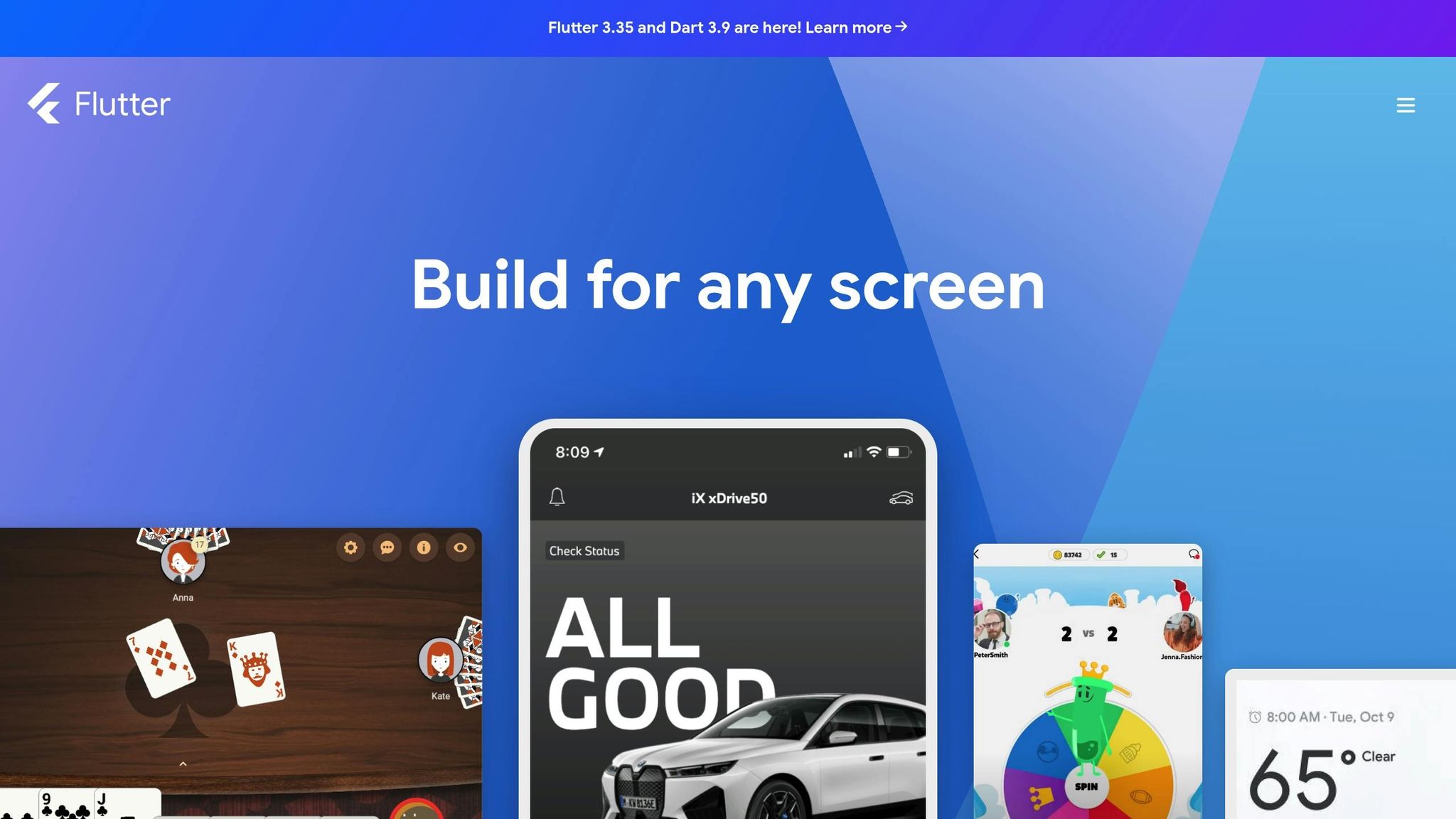
React Native and Flutter Overview
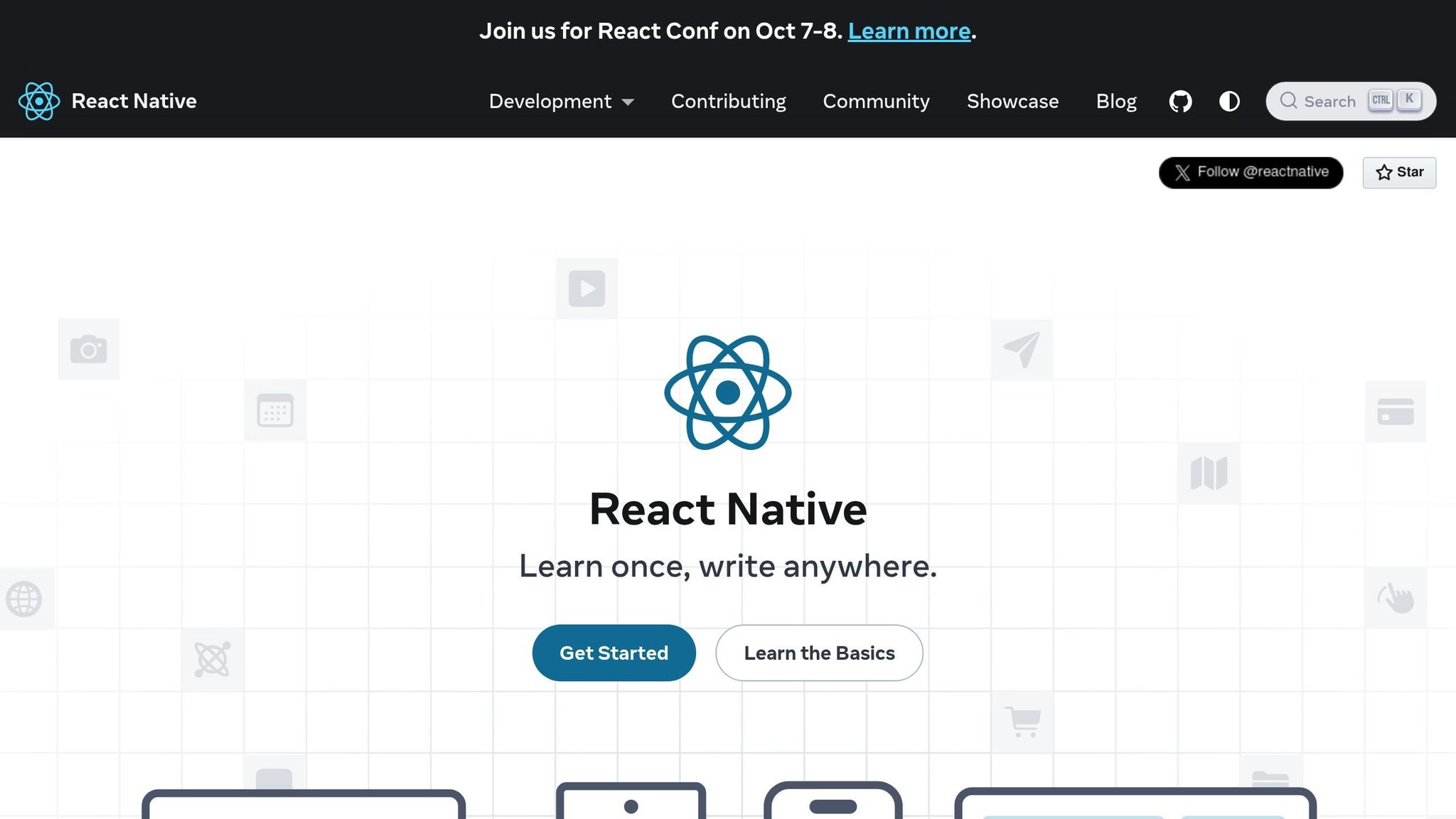
Before diving into how React Native and Flutter apply to construction apps, it’s important to understand the basics of these two frameworks. Both have become key players in mobile development, offering efficient ways to create apps with native-like performance across multiple platforms.
What is React Native?
React Native, developed by Meta, is a JavaScript framework that uses native UI components to create interfaces for both iOS and Android. Unlike web-based wrappers, React Native directly renders native platform UI elements. This means your construction app will rely on the same native components used in traditional app development for iOS and Android [1][2][3].
The framework builds on the Node.js and JavaScript ecosystems, which many developers are already familiar with. Tools like React Native CLI and Expo further streamline the development process [4][5]. For teams with a background in web development, this familiarity significantly lowers the barrier to entry when transitioning to mobile app development.
What is Flutter?
Flutter, created by Google, uses the Dart programming language and compiles directly to machine code. It relies on its own rendering engine, Impeller, to deliver pixel-perfect designs across platforms [4][5][6][8]. While Dart may not be as widely known as JavaScript, it offers distinct advantages for building complex applications.
At the core of Flutter’s architecture is its widget-based system, where everything, from layouts to interactive elements, is a widget. This structure allows for a high degree of customization, making Flutter an excellent choice for construction apps requiring unique UI features like interactive floor plans or advanced data visualization tools.
As of April 2025, Flutter has surpassed React Native on GitHub with over 170,000 stars compared to React Native’s 121,000+ stars [5][7]. It is currently regarded as the leading cross-platform framework, with React Native maintaining a strong second position [7].
Main Architecture Differences
React Native integrates seamlessly with platform-specific UI components, while Flutter takes full control of rendering to ensure a consistent design across all devices [4][5][7]. However, React Native’s reliance on native elements can mean extra work to achieve consistent custom designs across platforms [4][5][7]. For construction apps where branding or unique interface elements must look identical on both iOS and Android, developers may need to write platform-specific code.
Flutter’s ability to deliver uniform designs is particularly useful for construction teams that rely on a mix of devices. Whether a project manager uses an iPhone or a Samsung tablet, the app will look and function the same, ensuring a consistent user experience.
The choice of programming language also plays a role in long-term development. Dart’s strong typing and null safety help catch errors early, making the code more reliable and easier to maintain [6][7]. This can be a crucial advantage for large-scale construction apps managing sensitive project data. On the other hand, JavaScript’s flexibility and vast ecosystem provide extensive libraries and community support, which can speed up the development process [4][5][7].
Next, we’ll explore how these architectural differences affect the performance and user experience of construction apps.
Performance and User Experience for Construction Apps
Construction apps need to deliver quick startups, handle blueprints efficiently, and process complex data seamlessly. The framework you choose can significantly influence how well these demands are met.
Performance Benchmarks
Flutter and React Native take different architectural paths, and those choices affect performance. Flutter compiles directly to native machine code, skipping the JavaScript bridge entirely. This can result in smoother execution for tasks like rendering detailed floor plans or crunching large datasets. When it comes to handling heavy graphics – think 3D models or high-resolution site images – Flutter’s rendering engine often delivers a smoother experience. That said, the actual performance will depend on how the app is built.
Flutter apps tend to start with higher memory usage but maintain steady performance even during demanding operations. React Native apps, on the other hand, usually have a smaller initial memory footprint but can show variability under heavy loads.
Battery efficiency is another critical factor for construction teams working long hours in the field. Flutter’s rendering optimizations often result in better battery performance, while React Native apps may need additional fine-tuning to achieve similar results.
Next, let’s explore how these performance differences impact user interface consistency in real-world construction scenarios.
UI Consistency and Interface Design
While performance is key, a consistent and user-friendly interface is just as important for construction apps. Teams often work across a mix of iOS and Android devices, so having a uniform interface can make training easier and improve usability. Flutter’s design system is structured to deliver a consistent look and feel across platforms, making it easier to create tools like forms and interactive features tailored for construction tasks.
React Native, by using native components, aligns with platform-specific guidelines. However, this can lead to slight visual differences between iOS and Android. Developers may need to make additional tweaks to ensure elements like date pickers or dropdown menus behave consistently across devices.
Customization plays a big role in construction apps, too. Flutter’s extensive widget system allows developers to create unique components – such as interactive site maps or custom measuring tools – without being limited by platform differences. In contrast, React Native might require platform-specific code to achieve similar results.
Touch responsiveness is another critical factor, especially in dynamic field environments. Whether users are wearing gloves or working outdoors, the way each framework handles touch interactions can significantly impact the app’s overall usability.
Offline Features and Real-Time Data Sync
Construction sites often face spotty internet connectivity, making offline functionality a must-have. Both Flutter and React Native support offline use, but their approaches differ.
Flutter integrates well with local databases like SQLite and uses synchronous data access methods, which simplifies features like progress tracking or saving media files locally. React Native also handles offline functionality through tools like AsyncStorage and Realm, but its asynchronous model may require extra effort to manage offline data and syncing.
For real-time collaboration – such as live project updates or team messaging – stability and state management are key. Flutter’s built-in support for WebSocket connections helps maintain updates effectively. React Native, however, often relies on third-party libraries or custom solutions to achieve similar results.
Media synchronization, including photos, videos, and documents, brings additional challenges. Flutter’s platform channels allow direct access to native file systems, making it easier to handle large media files. React Native can manage similar tasks but might require extra optimization to ensure smooth performance during large data transfers.
Finally, background data synchronization is crucial for updating project details when connectivity improves. Flutter integrates well with platform-specific background processing tools, simplifying this task. React Native developers may need to implement additional measures to handle background operations efficiently.
Development Speed and MVP Timelines
Getting a construction app to market quickly can be the difference between grabbing early customer interest or falling behind competitors. Both React Native and Flutter offer faster development paths, but their distinct approaches can influence your timeline and budget.
Developer Learning Curve
The learning curve for developers plays a big role in how quickly you can assemble a team and start building. In the U.S., many developers already have strong JavaScript experience, making it easier to find talent familiar with React Native. On the other hand, Flutter uses Dart, a language developed by Google, which often requires developers to spend time learning it.
React Native takes advantage of developers’ existing JavaScript knowledge, streamlining the onboarding process. Flutter, however, introduces a widget-centric design approach, which can take some time to master. That said, developers often find Dart intuitive once they get the hang of it, especially when working on complex features like project management dashboards or equipment tracking tools. As Flutter gains traction, the availability of skilled developers is improving, particularly in major tech hubs. This difference in familiarity also impacts the tools and libraries developers use during the build process.
Tools and Third-Party Libraries
Construction apps typically require features like GPS tracking, camera functionality, file handling, and maps. React Native benefits from JavaScript’s extensive ecosystem, offering a wide range of libraries to support these needs, such as site location tracking, photo documentation, and document management. Flutter, while newer, provides a curated selection of packages tailored for mobile development, covering similar features like maps, image handling, and file management.
Integration with third-party services is another critical factor. Construction apps often need to connect with platforms for project management or accounting. React Native’s mature ecosystem usually offers pre-built integrations, while Flutter projects may need custom API work to achieve the same functionality.
Development tools also play a role in speeding up the process. React Native developers often rely on familiar editors like VS Code, while Flutter integrates seamlessly with tools like Android Studio and VS Code, offering features like performance profilers and widget inspectors to streamline development.
Hot Reload and Code Reuse
Both React Native and Flutter support rapid prototyping through features like hot reload, which allows developers to see changes instantly. Flutter’s hot reload retains the app’s state during UI updates, while React Native’s Fast Refresh works efficiently with simpler state management setups.
Cross-platform code reuse is another major advantage. Both frameworks allow developers to share a significant portion of code between platforms, cutting down on development time and costs. This is especially valuable for startups aiming to launch a minimum viable product (MVP) quickly.
The actual development timeline, however, depends on the app’s specific requirements. Apps focused on tasks like data collection, photo management, and basic project tracking benefit the most from cross-platform frameworks. In contrast, apps requiring advanced visualizations, augmented reality, or integration with specialized construction hardware may still need additional platform-specific work.
sbb-itb-51b9a02
Scalability and Long-Term Maintenance
Beyond just speeding up development and reusing code, ensuring easy maintenance and scalability over time is crucial for any construction app’s success. Scalability often means being able to add new features and integrate smoothly with essential U.S. construction software. Since construction projects frequently depend on tools for accounting, project management, and other specialized systems, strong integration capabilities are a must.
Integration with US Construction Services
Both React Native and Flutter offer solid options for integrating with U.S. construction services, but they take slightly different approaches. React Native benefits from a well-established ecosystem, offering a variety of pre-built integrations and libraries that make connecting with widely-used U.S. construction tools easier. On the other hand, Flutter might require more custom development to work with older or niche systems. However, this extra effort can result in more tailored and precise integrations. The right choice ultimately depends on your app’s specific integration needs and the level of customization you’re aiming for.
React Native vs Flutter Comparison Table
Use the side-by-side comparison below to help determine which framework aligns best with your construction app needs.
| Factor | React Native | Flutter |
|---|---|---|
| Performance | Offers near-native performance, though the JavaScript bridge can sometimes add overhead. | Compiles directly to native code, ensuring smooth animations. |
| Development Speed | Quick to set up and offers access to numerous third-party libraries. | Setup may take slightly longer but includes a rich library of built-in widgets. |
| Code Reuse | Allows extensive code sharing between iOS and Android platforms. | Provides high code reuse from a single codebase across multiple platforms. |
| Learning Curve | Easier for developers familiar with JavaScript. | Requires learning Dart, but the architecture is straightforward. |
| UI Consistency | Delivers a platform-specific look and feel. | Ensures consistent design across platforms with built-in design frameworks. |
| Offline Capabilities | Supports offline functionality with additional libraries. | Built-in tools simplify offline-first app development. |
| Real-Time Features | Supports real-time updates via WebSockets and push notifications. | Natively handles real-time data with a stream-based architecture. |
| Hot Reload | Includes Fast Refresh for a quicker development cycle. | Features stateful hot reload, preserving app state during updates. |
| Community Support | Supported by a large, well-established community with extensive resources. | Backed by a growing community and strong support from Google. |
| Third-Party Integrations | Extensive library ecosystem for added functionalities. | May require custom development for specific third-party integrations. |
| App Size | Results in a smaller base app size. | Base app size tends to be larger due to its engine. |
| Maintenance | Sometimes needs platform-specific adjustments. | Unified codebase simplifies long-term maintenance. |
| Enterprise Adoption | Widely adopted by large enterprises. | Increasingly popular in enterprise settings. |
| Cost Efficiency | Can reduce initial development costs. | May have higher upfront costs but could lower maintenance expenses. |
| Scalability | Suitable for projects of all sizes, from small apps to large-scale solutions. | Ideal for building complex, feature-heavy applications. |
React Native and Flutter each have strengths that cater to different development needs. React Native is a great fit if your team is already comfortable with JavaScript and you need to move quickly. It’s particularly effective for integrating key features commonly used in construction apps.
On the other hand, Flutter is perfect for developing intricate, custom applications. Its robust UI toolkit is ideal for creating detailed floor plan viewers or advanced data visualization tools. If your startup is working with tight deadlines and budgets, React Native might be the better choice. However, if your focus is on building a complex platform with long-term goals, Flutter could be the way to go.
This breakdown provides a solid foundation for selecting the right framework for your US construction startup.
Choosing the Right Framework for US Construction Startups
When deciding between React Native and Flutter, your choice can shape your startup’s direction, impact your budget, and influence long-term outcomes. To make the best decision, it’s essential to weigh key factors that align with your business goals and technical needs.
Key Decision Factors
Team Expertise and Hiring Strategy
The size of the talent pool is a significant factor. React Native has a larger presence in the US job market, with 6,413 job postings compared to Flutter’s 1,068 on LinkedIn [10]. This makes it easier to find skilled developers, speeding up onboarding and reducing costs. If your team already has experience with JavaScript and React, React Native offers a smoother learning curve, helping you hit the ground running.
MVP Timeline and Speed to Market
Both frameworks are excellent for rapid prototyping, but the best choice depends on your app’s focus. React Native might be quicker for teams already familiar with JavaScript, while Flutter could save time for apps that are heavily focused on UI, such as blueprint viewers or interactive dashboards.
Budget Considerations and Cost Efficiency
While both frameworks lower costs by allowing code reuse, React Native often has lower upfront expenses due to the larger pool of available developers. On the other hand, Flutter, with its unified codebase, may reduce long-term maintenance costs, though it might require additional training initially.
UI/UX Requirements
For construction apps that demand precise designs or intricate animations, Flutter’s widget-based system provides unmatched control. However, if you want your app to closely mimic the native look and feel of iOS and Android, React Native is a better fit.
Long-term Scalability and Performance Needs
As your startup grows, scalability becomes critical. Flutter’s direct native code compilation and React Native’s Bridgeless Architecture (introduced in version 0.74) both offer strong performance. React Native’s use of the JavaScript Interface (JSI) enhances communication between JavaScript and native layers, making it a solid choice for scalable applications [9][11].
Integration Requirements
React Native’s rich ecosystem of third-party libraries makes it easier to integrate with construction management systems, payment platforms, and other APIs commonly used in the industry. Flutter, while powerful, might require more custom development for similar integrations.
Market Trends and Future-Proofing
In 2022, 46% of developers reported using Flutter, compared to 32% for React Native. Flutter also boasts 170,000 stars on GitHub, surpassing React Native’s 121,000 [10][7]. However, the greater number of React Native job postings suggests a more established presence in enterprise projects, which could be a deciding factor for startups aiming for long-term stability.
These considerations are critical for making an informed choice, which is where AlterSquare’s expertise can make a difference.
How AlterSquare Can Help
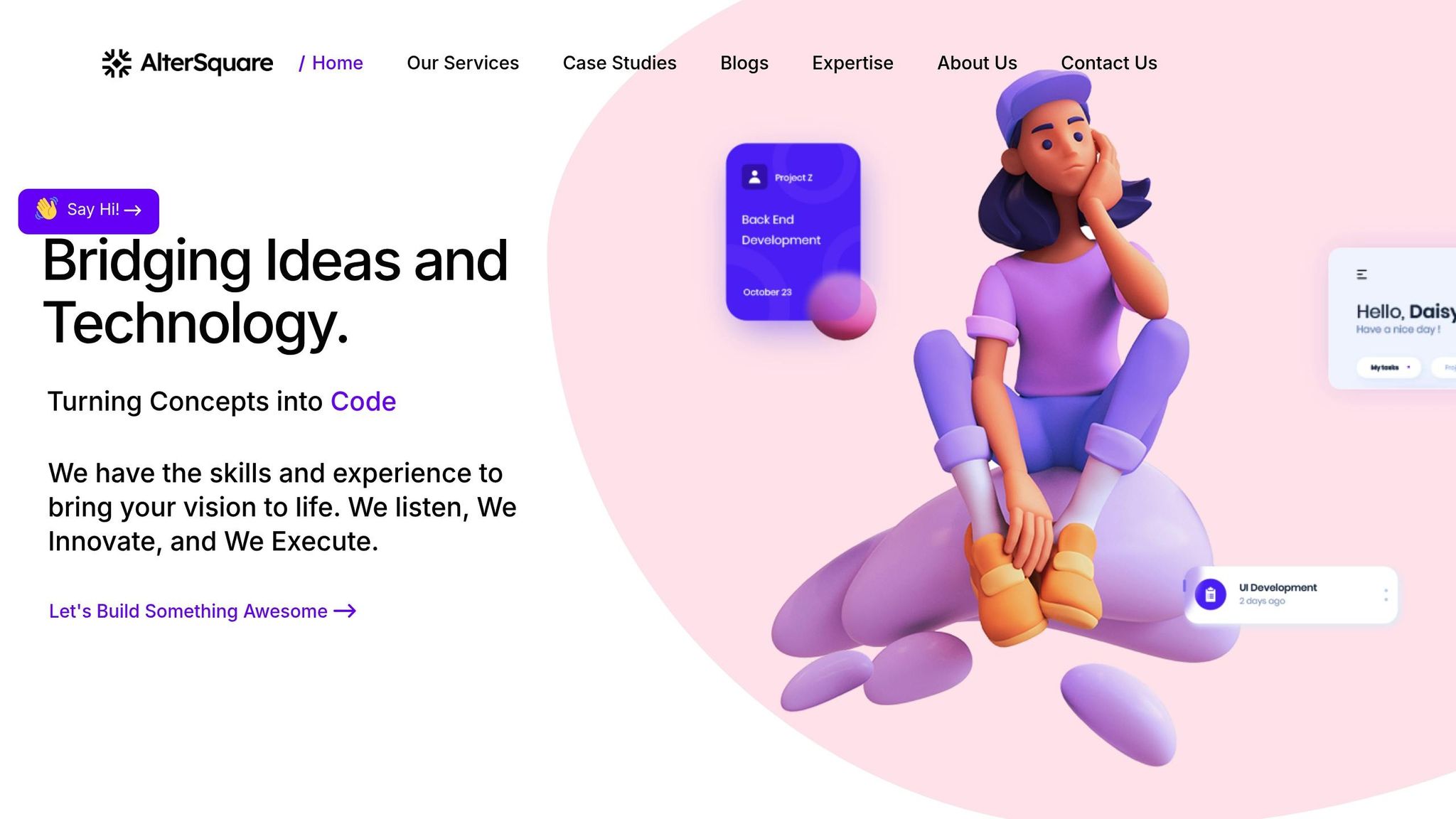
Navigating these decisions can be daunting, but AlterSquare’s services are designed to guide startups through every step. Their 90-day MVP program helps construction startups quickly develop market-ready apps while ensuring the chosen framework aligns with your business needs.
The process starts with a comprehensive tech-stack consultation to evaluate your team’s capabilities, app requirements, and growth objectives. AlterSquare then employs rapid prototyping sprints, creating proof-of-concept versions in both React Native and Flutter. This approach allows you to test performance and gather user feedback before committing to a framework.
AlterSquare’s phased delivery framework includes:
- Discovery & Strategy: Identifying your unique needs and goals.
- Design & Validation: Creating user-focused designs and validating them through testing.
- Agile Development: Building your app iteratively for flexibility and speed.
- Launch Preparation: Ensuring your app is ready for deployment.
- Post-Launch Support: Providing ongoing updates and improvements.
Their expertise extends to technologies like Vue.js, Nuxt.js, GoLang, and Node.js, ensuring your app’s frontend and backend work seamlessly together. For non-technical founders, AlterSquare simplifies complex technical choices, while technical founders can leverage their deep knowledge of construction app development, including offline-first architectures and field management tool integrations.
By incorporating AI and generative-AI tools, AlterSquare accelerates development timelines, helping startups achieve faster results compared to traditional methods. Their post-launch services ensure your app evolves alongside your business, meeting new challenges as they arise.
With a proven track record of rescuing stalled projects and delivering measurable improvements in revenue and customer satisfaction, AlterSquare offers the support your startup needs to make informed technical decisions that drive both short-term success and long-term growth.
Conclusion
Deciding between React Native and Flutter for your construction app is a critical step that can influence your startup’s growth and success. Both frameworks bring distinct strengths to the table, and with their performance differences narrowing, the choice often comes down to your specific needs and objectives.
React Native is a solid option for many U.S. construction startups, especially if your team already has JavaScript expertise or you’re working with a limited hiring budget. Its established ecosystem and larger developer community make it easier to find talent, onboard new team members, and integrate with existing tools like construction management systems and payment platforms – key components for field operations.
On the other hand, Flutter stands out when your app requires high-precision UI designs or advanced animations. This makes it an excellent choice for apps with interactive blueprint viewers or detailed project dashboards. Thanks to its widget-based architecture and native compilation, Flutter ensures smooth and consistent performance across devices, which is especially valuable when visual accuracy is a priority.
For startups watching their budgets, React Native’s strong community support can help cut initial costs, while Flutter’s single codebase can reduce long-term maintenance efforts. The right choice depends on aligning your framework with your team’s skills and your app’s priorities – whether that’s fast market entry, seamless integration with third-party tools, or creating a visually polished user experience.
AlterSquare simplifies this decision-making process by offering expert consultations and rapid prototypes in both frameworks. This approach allows you to test performance and gather user feedback before committing to a specific direction.
Whether you lean toward React Native for its established ecosystem or Flutter for its superior UI capabilities, the key to success lies in making a thoughtful, well-informed choice. For construction startups, selecting the right framework is the first step toward building scalable, user-friendly solutions that meet the demands of modern project management.
FAQs
How do I decide between React Native and Flutter for building a construction app?
When deciding between React Native and Flutter for a construction app, it’s essential to weigh your priorities:
- Performance and UI precision: Flutter stands out with its unique rendering engine, which ensures smooth animations and a consistent, polished design. If your app demands a visually refined interface and seamless performance – qualities often crucial for construction tools – Flutter can be a strong contender.
- Development speed and ecosystem: React Native, built on JavaScript and leveraging native components, enables faster development cycles. Its compatibility with existing JavaScript-based systems and a large, active community make it ideal for quick MVP development and scaling over time.
Your choice ultimately hinges on what matters most: a visually striking, high-performance app or quicker development with easier integration into current technologies.
How do React Native and Flutter support offline functionality and real-time data syncing for construction apps?
Both React Native and Flutter offer reliable solutions for handling offline functionality and real-time data syncing, making them a great fit for construction apps where internet access can often be spotty.
With React Native, tools like Redux Persist and SQLite allow data to be stored locally. This means users can keep working even without an internet connection. Once the app regains access to the internet, it automatically syncs with the server, ensuring all updates are reflected.
Flutter also excels in offline-first capabilities, utilizing local databases like SQLite and Hive. Additionally, libraries such as Syncable make it easy to synchronize data across devices, ensuring everything stays consistent and up-to-date when the connection is restored.
Both frameworks are designed to handle the challenges of low-connectivity environments, offering dependable offline functionality and smooth data syncing to keep construction teams productive, no matter where they are.
What are the long-term maintenance challenges of using React Native versus Flutter for a construction app?
When it comes to long-term maintenance, Flutter has a clear edge. Its single codebase works seamlessly for both iOS and Android, cutting down the need for platform-specific tweaks. This streamlined approach simplifies updates and trims down ongoing maintenance efforts, making it a smart, budget-friendly option for building scalable construction apps.
In contrast, React Native often leans on native modules to handle certain features. While this adds flexibility, it can also increase maintenance demands, especially when resolving platform-specific issues or integrating native components. Additionally, React Native may require more frequent updates to keep up with changes in native platforms.
In summary, Flutter tends to be a more reliable choice for long-term projects, especially when scalability and lower maintenance costs are key considerations.
Related posts
- Mobile-First Construction: Bringing Field Operations into the Digital Age
- Responsive Design for Construction Sites: Making Web Apps Work in the Field
- Building Construction Software with Vue.js: Why We Choose It for Complex Applications
- Construction Software User Experience: Why Most Apps Fail on Job Sites

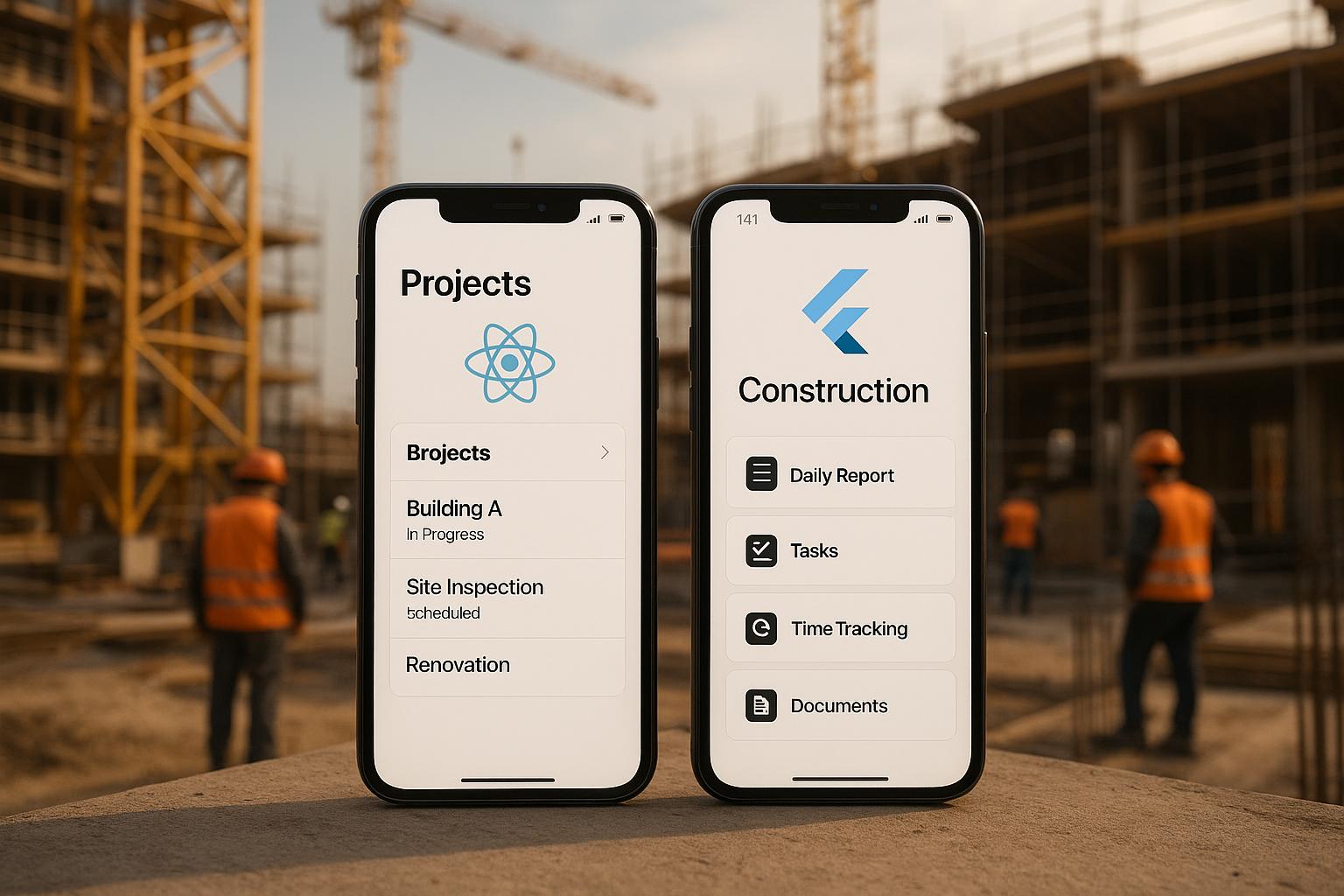


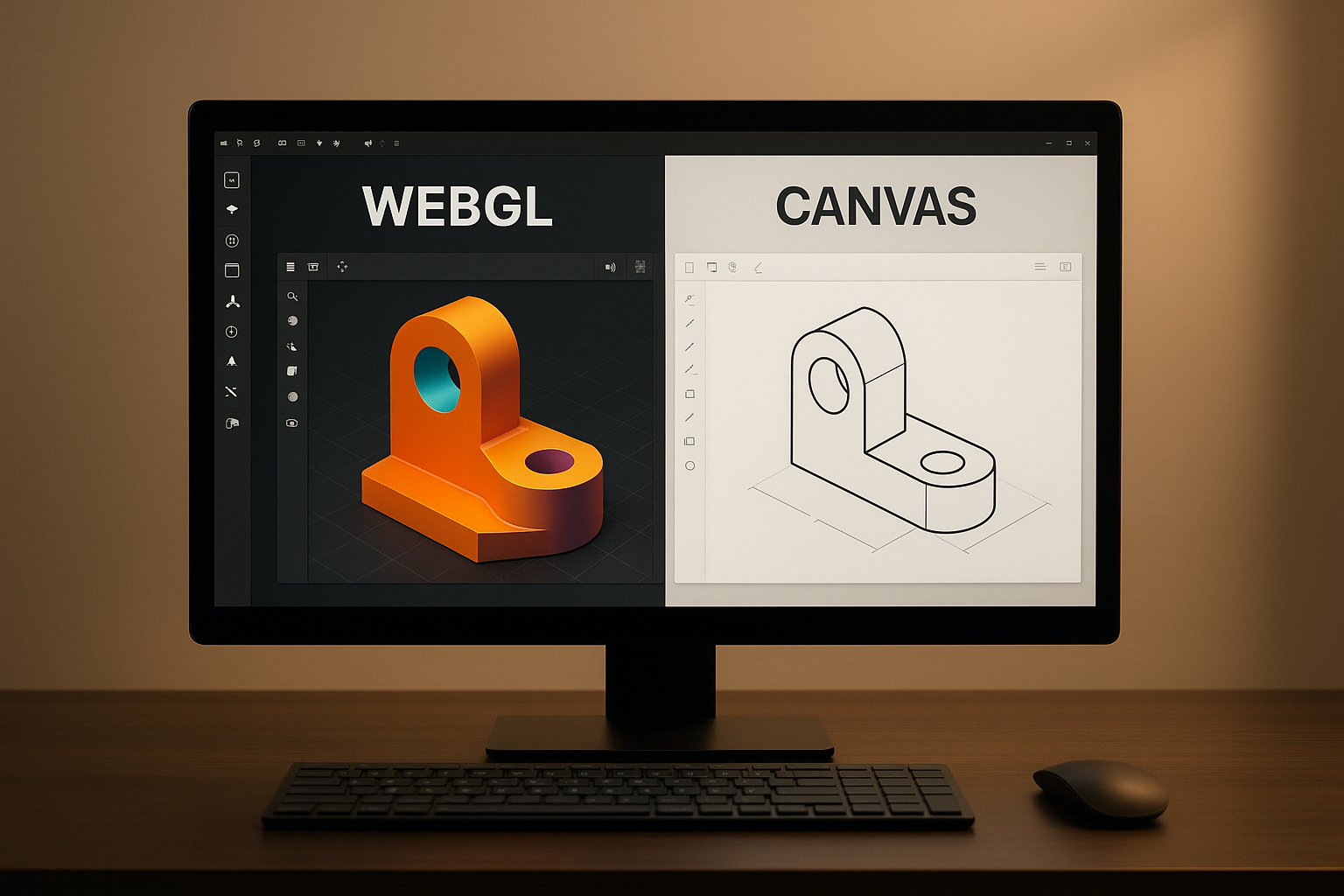




Leave a Reply